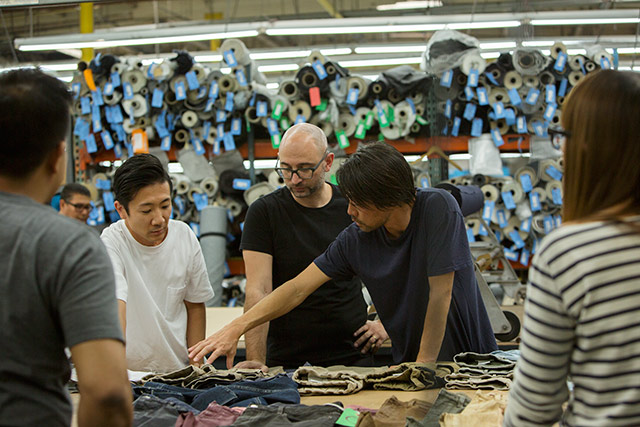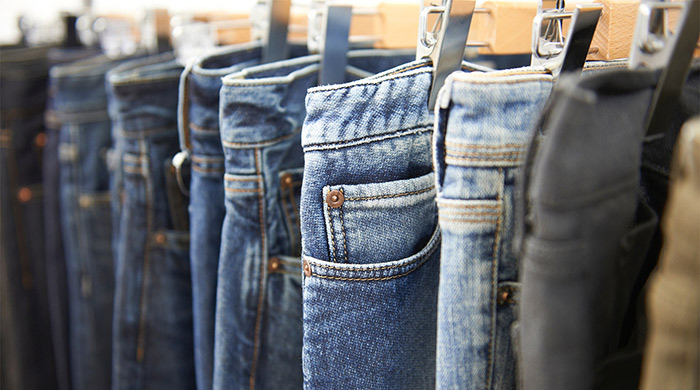Jeans from Japan have a reputation among denim enthusiasts for being the best in the world, whether it is about its quality or methods of production. So imagine my excitement when I was invited to visit the Kaihara mill, a textile house in Fukuyama City, Hiroshima that supplies fabric for Uniqlo jeans. Together with members of the media and Uniqlo representatives from around the world, we left our hotel in Onomichi in four big busses. When a fashion editor enthused that it felt like a school field trip, little did I know that I was going to learn a whole lot about everyone’s favourite wardrobe staple.
Although we were aware of the cleanliness in Japan, upon arriving at Kaihara, we were in awe of how spotless the mill was. As we were given a tour in groups, the mill’s representatives explained thoroughly of how denim is made, from spinning to finishing. Founded in 1951, Kaihara is a relative newcomer to the world of Japanese textiles but they have managed to be on par with the older mills through their innovations. The mill initially produced kasuri (fabric whose yarn is dyed to produce a pattern or image when woven) that involved traditional non-chemical dyeing methods. Fast-forward to 1970, Kaihara developed rope dyeing, becoming the first Japanese company to produce denim.
If you noticed why Uniqlo denim has a weathered appearance that gains character over time, the secret lies in the world-class rope dyeing process. The exterior of the yarn is a stunning indigo blue while the core retains cotton’s natural white. In fact, only denim woven from such yarn can furnish fading’s attractive gradual changes.
Today, as one of the world’s top denim manufacturers, the textile quality is so high that the Japanese mill is synonymous worldwide with premium denim. It is no surprise why: the facility employs only raw cotton harvested from high quality cotton that is good enough for fine shirts. Not only that, Kaihara is committed to producing vintage denim on old-fashioned shuttle looms originally deployed in the seventies and early eighties. As compared to an advanced high-speed loom that can produce about 350 meters of yarn daily, the daily limit for an old-fashioned shuttle loom is about 120 meters. However, Kaihara is dedicated to denim traditions when producing authentic denim that it sacrifices productivity in favour of vintage denim’s telltale texture.
Kaihara has dyed around one million
kilometers of rope since the ’70s,
enough to circle the earth 25 times
{insert gallery tpl=”slide-freesize.tpl” id=”Uniqlo Kaihara” rid=”4887″ order=”a_tstamp”}
After the fun educational visit at Kaihara, we flew to Tokyo where I had the opportunity to speak to director of Fast Retailing Denim Innovation Center, Masaaki Matsubara as he talks about Uniqlo jeans, innovative technologies and the new Denim Innovation Centre in California.
Congratulations on the Denim Innovation Center (DIC) in Los Angeles! Could you tell us more about the new R&D center?
The DIC is Fast Retailing Group’s first facility to focus on research and development of denim fabric. Just like Japan, L.A. is a city well-known as the home of denim. This R&D center serves as a global hub where specialists are brought together to develop jeans utilizing innovative technologies and materials. The first project for the facility will be research on jeans for Uniqlo and the products will be available from the Autumn/Winter 2017 season.

Uniqlo focuses on classic, everyday basics. Would you say that trends are secondary?
Both are important. While there are fashion trends, there are many other trends as well, and we are dedicated in translating them into our customers’ needs. We strive to offer not only wardrobe essentials but also, innovative denim such as ‘Miracle Air Jeans’. By remaining authentic and relevant to our consumers, we successfully occupy a good position in the market place.
Speaking of innovations, which technology are you most proud of?
The ultra-stretch jeans, definitely. In the past, stretchability in denim was almost unheard of. Today, through our innovative technology, Uniqlo denim has twice the elasticity yet it easily reverts back to its original shape.
Does it add pressure to you for coming up with new innovations every season?
To a certain extent, yes. I have been in the fashion industry for over 20 years now, and I’m always under pressure (laughs). But I’d say that now is the highlight of my career. I’ve been very fortunate for having so many opportunities.
Being in this field for so many years, what is the most interesting thing you have learned about denim?
To me, denim is a very unique item. The more you wash it, the more distressed it gets, giving it more character. I think that quality does not exist in other types of clothing. While there is not much versatility or range in designing denim, we strive to make our denim more comfortable. It’s a daily effort.
As a Japanese brand, how much of Japanese elements are put into the creation of Uniqlo denim?
Well, the foundation of our approach definitely lies in the traditional Japanese craftsmanship. However, at the same time, we always challenge ourselves into creating more innovative denim. That’s where the employment and engagement of technology comes in.
What can we expect from Uniqlo denim in the new season?
We are constantly reaching new lengths, literally. It used to be a matter of cuts, either it is skinny or straight but now the length of the jeans plays an increasingly important factor in the proportions. Additionally, we are also coming up with different shades, so there will be more types of denim washing.
Related stories:
4 Buro readers take on Christophe Lemaire’s first Uniqlo U collection
4 personalities are going places with Uniqlo LifeWear Fall/Winter 2016
Non-basic basics are the backbone of Uniqlo U Spring/Summer 2017
| SHARE THE STORY | |
| Explore More |




